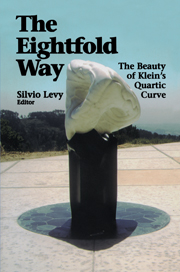Book contents
- Frontmatter
- Contents
- Preface: MSRI and the Klein Quartic
- The Eightfold Way: A Mathematical Sculpture by Helaman Ferguson
- The Geometry of Klein's Riemann Surface
- The Klein Quartic in Number Theory
- Hurwitz Groups and Surfaces
- From the History of a Simple Group
- Eightfold Way: The Sculpture
- Invariants of SL2(𝔽q) . Aut(𝔽q) Acting on ℂn for q = 2n ± 1
- Hirzebruch's Curves F1 , F2 , F4 , F14 , F28 for Q(V7)
- On the Order-Seven Transformation of Elliptic Functions
Hurwitz Groups and Surfaces
Published online by Cambridge University Press: 25 June 2025
- Frontmatter
- Contents
- Preface: MSRI and the Klein Quartic
- The Eightfold Way: A Mathematical Sculpture by Helaman Ferguson
- The Geometry of Klein's Riemann Surface
- The Klein Quartic in Number Theory
- Hurwitz Groups and Surfaces
- From the History of a Simple Group
- Eightfold Way: The Sculpture
- Invariants of SL2(𝔽q) . Aut(𝔽q) Acting on ℂn for q = 2n ± 1
- Hirzebruch's Curves F1 , F2 , F4 , F14 , F28 for Q(V7)
- On the Order-Seven Transformation of Elliptic Functions
Summary
Hurwitz not only gave an upper bound for thenumber of automorphisms of a compact Riemannsurface of genus greater than 2, but also gave acharacterization of which finite groups could begroups of automorphisms achieving this bound. Inpractice, however, the identification of suchgroups and of the surfaces they act on isdifficult except in special cases. We survey whatis known.
1. How I Got Started on Hurwitz Groups
One day in the late 1950's, rereading Siegel's article[1945] entitled “Some remarks on discontinuousgroups”, I was struck by his proof that the smallestarea of fundamental region for a Fuchsian group isπ /21. Siegel notesthe remarkable similarity between the arithmeticused in his proof and the arithmetic in Hurwitz'sproof that a curve of genus g ≥ 2 has no more than 84(g - 1) birationalself-transformations. That, he said, is notsurprising because of the theory of uniformization.That was all- no indication where to find Hurwitz'spaper, at that time unknown to me. (Siegel is one ofmy heroes, but, it must be confessed, he was notvery good at citing references.) I did know aboutuniformization, and I made that connection at once.However, I had some trouble tracking down Hurwitz'stheorem. Finally, thanks to the late Professor W. L.Edge, I read Hurwitz's paper [1893], which invokedKlein's surface as an example to show that his boundwas attained. So at last, by a very tortuous path, Iunearthed this chapter of mathematics, which hasfascinated me ever since.
Information
- Type
- Chapter
- Information
- The Eightfold WayThe Beauty of Klein's Quartic Curve, pp. 103 - 114Publisher: Cambridge University PressPrint publication year: 1999
